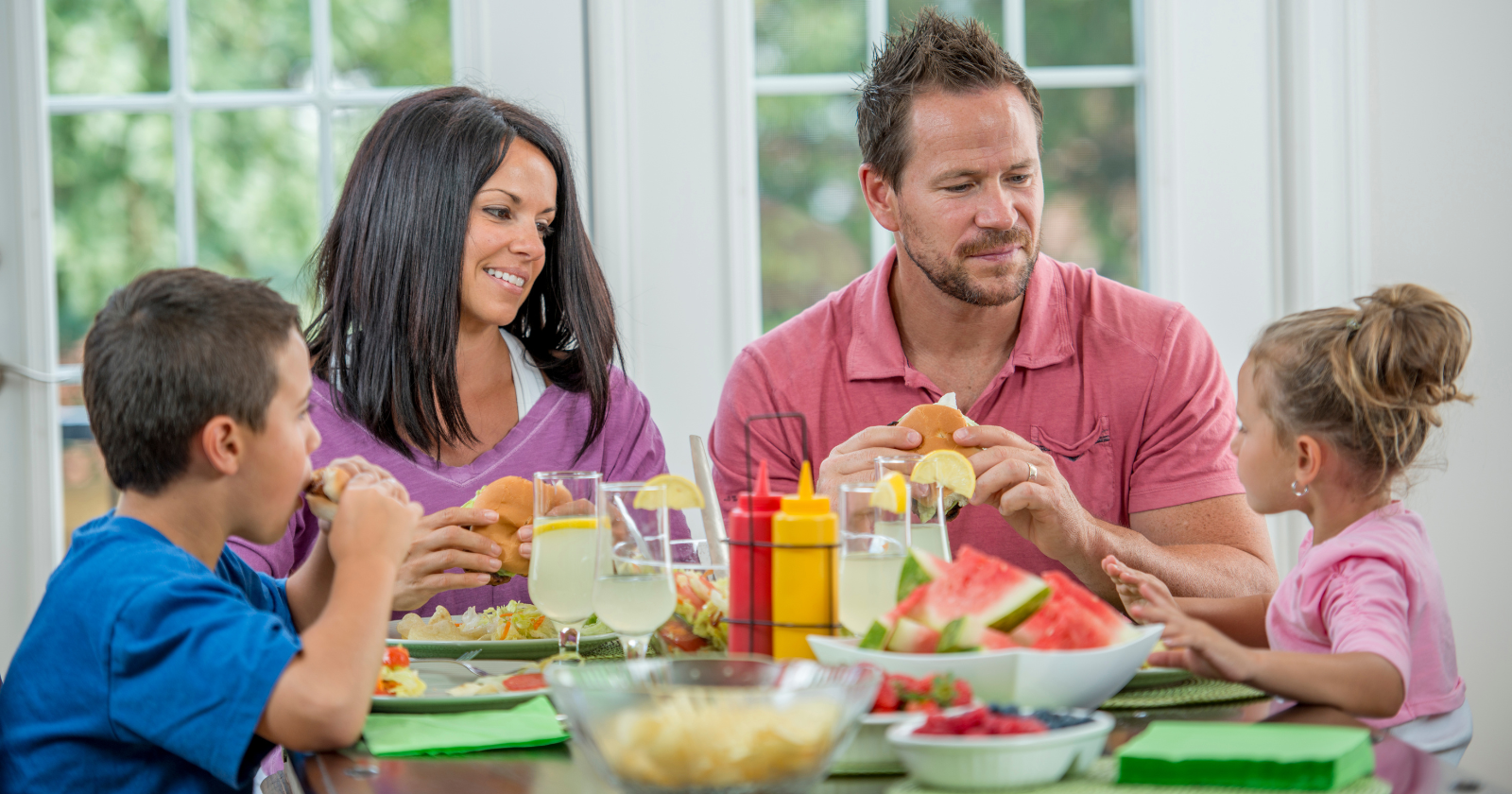There’s something quietly sacred about sitting around a table together. Not for a special occasion or a fancy dinner, just a regular Tuesday with mismatched plates, laughter, and maybe a few crumbs left behind.
In my home, some of the most meaningful conversations have unfolded between bites of pasta or spoonfuls of soup.
When my boys were younger, they’d talk about their school days, but as they grew up, the stories changed to dating, job interviews, and the little challenges of adult life.
Somewhere between the salt and the serving dishes, those moments became a thread that kept us connected.
And it turns out, science agrees that those simple, shared meals matter more than we realize. “Children who routinely eat their meals together with their family are more likely to experience long-term physical and mental health benefits”.
That goes far beyond nutrition, touching something deeper; the emotional nourishment that comes from being together.
Here are eight ways that gathering for meals can strengthen your family’s emotional health and maybe even heal a few invisible cracks along the way.
1. It builds a sense of belonging
Family meals create something that’s hard to teach but easy to feel: belonging.
When everyone shows up to the same table, it sends a message, “You’re part of this.” It’s a small ritual that anchors children (and adults) in something steady and safe.
I remember how, when my youngest left for college, he told me he missed “the noise of dinner.”
Not the food, not the recipes, the noise. That hum of conversation, clinking cutlery, and shared space reminded him of home.
Related Stories from The Artful Parent
Studies have shown that shared meals contribute to lower risks of childhood depression, substance use, and eating disorders.
The emotional connection we build at the dinner table can buffer kids against so many of life’s pressures later on.
2. It invites real conversations
Ever notice how kids open up more when they’re distracted by their mashed potatoes? There’s something about the rhythm of eating that makes serious conversations feel less intimidating.
At our table, the rule was simple: everyone got a turn to talk, even if it was just about what they noticed that day. Sometimes it led to laughter, other times to surprising honesty.
One of my favorite memories was when my middle son admitted he felt “different” from his friends.
That dinner turned into a long talk about values, fitting in, and the courage to stand apart. Had we not been sharing a meal, I doubt he would have brought it up.
- I grew up fighting over the remote with my siblings—now my kids watch alone in separate rooms and it breaks my heart - Global English Editing
- People who have little to no relationship with their siblings usually had these 7 childhood experiences, says psychology - Global English Editing
- If someone mentions these 8 topics constantly, their social intelligence is probably below average - Global English Editing
Experts have noted that families who eat together tend to have stronger communication patterns.
It’s not about the number of words spoken but the feeling of being heard, and that’s what helps children develop emotional confidence.
3. It teaches gratitude in real time
Gratitude can’t be taught through lectures; children learn it by watching how we express it ourselves.
When we sit together and pause to appreciate the food, the effort behind it, or even each other’s company, it cultivates awareness.
Sometimes, I’ll say something simple like, “This stew turned out better than I expected, thanks for helping me chop the veggies!” That moment of appreciation, however small, changes the tone of the whole meal.
Kids who grow up in homes where gratitude is spoken aloud tend to notice more good in their own lives.
They start to see meals not as obligations but as moments of connection, and that mindset carries into adulthood.
4. It helps regulate emotions
I’ve noticed that meals often act as emotional checkpoints. You can tell when someone’s had a rough day just by the way they poke at their food or go quiet.
As a parent, those are the moments to tune in gently: “You seem quieter tonight. Want to talk about it?”
This kind of presence can be grounding. Emotional safety doesn’t come from never arguing or having perfect family harmony, it comes from knowing you can show up as you are and still be accepted.
And as noted by Ailsa Lord, Child & Adolescent Counselling Psychologist, “Children learn ways of coping with emotions by watching how their parents do this, and by watching how the parent responds to their child’s own emotions.”
When we model calm curiosity instead of judgment, we teach kids that emotions are safe to feel and express. Over time, those lessons become part of their emotional toolkit for life.
5. It connects body, mind, and heart
I used to rush through dinner after work, barely tasting my food. But as life slowed down in my fifties, I started to see how meals could become a form of mindfulness.
When we share food intentionally, chewing slowly, talking, laughing, we’re connecting body, mind, and heart in one simple ritual.
This idea reminded me of something I read in Rudá Iandê’s new book, Laughing in the Face of Chaos. He writes, “Your body is not just a vessel, but a sacred universe unto itself, a microcosm of the vast intelligence and creativity that permeates all of existence.”
His insights made me realize how often we treat meals as mechanical acts instead of sacred ones.
Sharing food goes beyond feeding the body and reminds us that our bodies, emotions, and relationships all belong to the same living conversation.
6. It gives children emotional vocabulary
So much of emotional intelligence begins with naming what we feel. And interestingly, mealtime conversations naturally create space for that kind of learning.
When a child says, “I’m mad at my teacher,” and we respond with curiosity instead of correction, we give them language for their inner world.
I remember one evening when my oldest son said he was “tired but not tired.” It led to a conversation about emotional exhaustion, a concept I didn’t even have words for until adulthood.
Family meals teach children that emotions can be talked about safely. That skill helps them form deeper friendships, healthier romantic relationships, and even better boundaries.
7. It strengthens family identity
Every family has its quirks, the inside jokes, the special recipes, the silly traditions. Shared meals help preserve them.
In our home, Friday nights were for homemade pizza, and everyone got to choose a topping. Sometimes we argued about pineapple, sometimes we invented new combinations. But it was ours.
Those small rituals give families a sense of identity beyond the daily grind. They remind us who we are when the world feels chaotic.
Experts have found that children raised in families with consistent routines and shared rituals tend to feel more secure. And security, in turn, is one of the strongest predictors of emotional resilience.
8. It teaches empathy and listening
Maybe the most beautiful thing about sitting at the same table is that it forces us to listen. You can’t talk over each other when you’re passing the salad or waiting your turn to share a story.
In a world that often rewards speaking louder, family meals quietly teach the opposite: empathy through attention.
I’ve found that when my sons listen to one another, really listen, it softens even their disagreements.
They may not always agree, but they learn to understand, and that’s a powerful skill to carry into adulthood.
The dinner table becomes an early classroom for compassion, and that’s something every emotionally healthy family needs more of.
Final thoughts
If there’s one thing I’ve learned, emotional health doesn’t depend on grand gestures. It grows quietly through small, consistent moments of connection.
Sharing meals has little to do with perfect manners or elaborate recipes. What matters most is showing up with your full, imperfect self and leaving space for everyone else to do the same.
As Rudá Iandê often reminds us in his teachings, wholeness begins when we stop trying to fix what feels broken and start embracing what’s already there.
Family meals have a beautiful way of bringing that truth to life. They show us that love doesn’t need to shout to be felt. Sometimes it’s found in a warm meal, a full table, and the calm comfort of being together.
So tonight, whether you’re unpacking takeout or serving something homemade, gather your people. Sit down, talk, listen.
These are the moments that nourish both the body and the heart.



